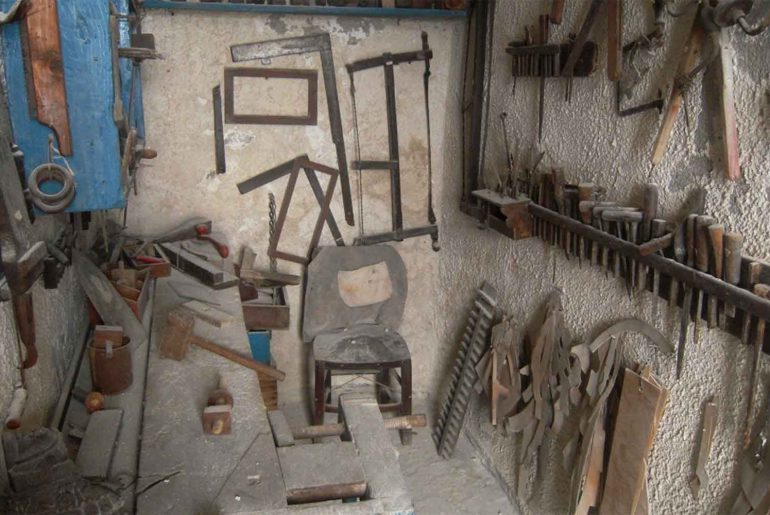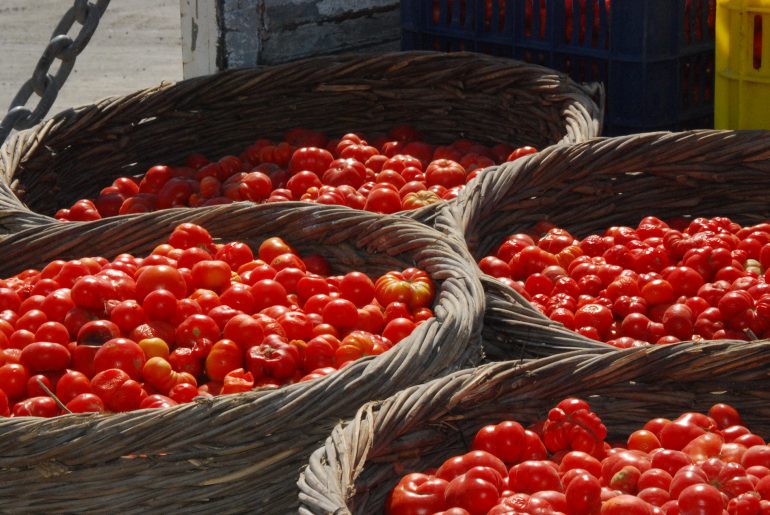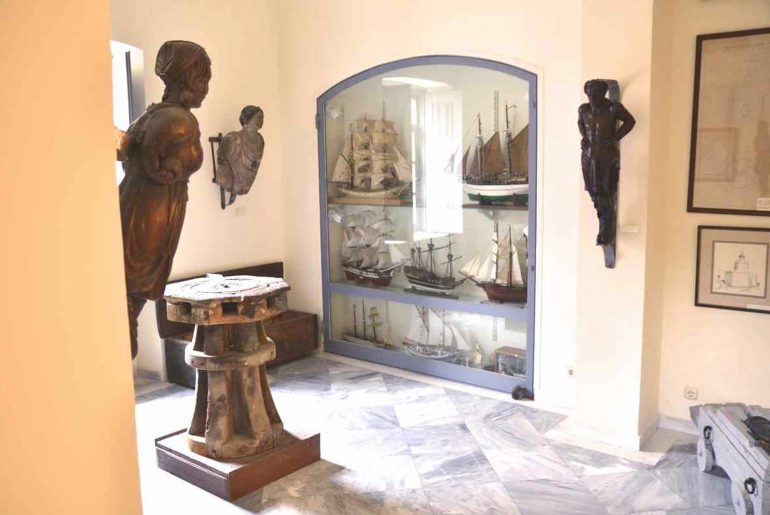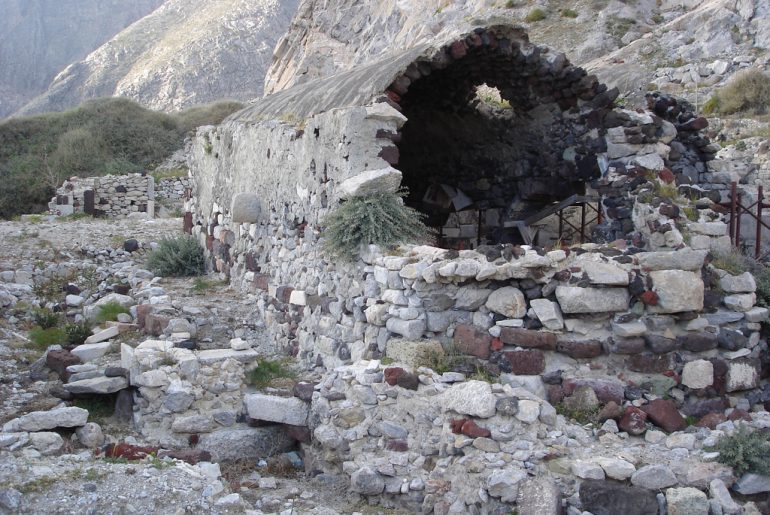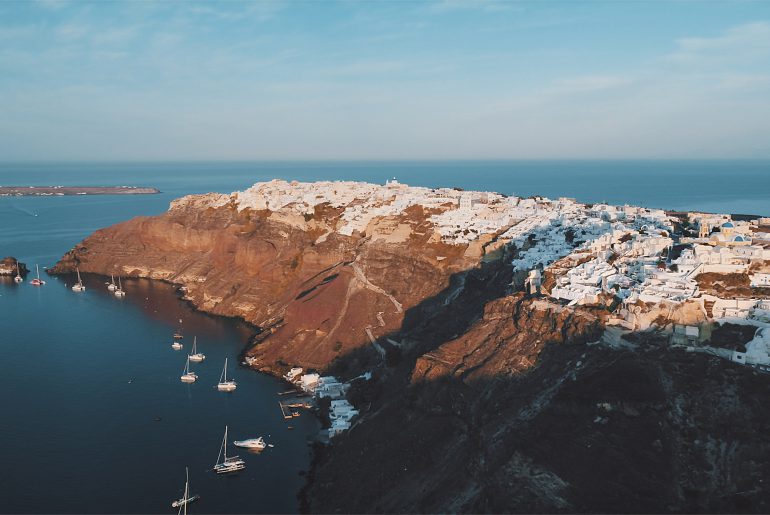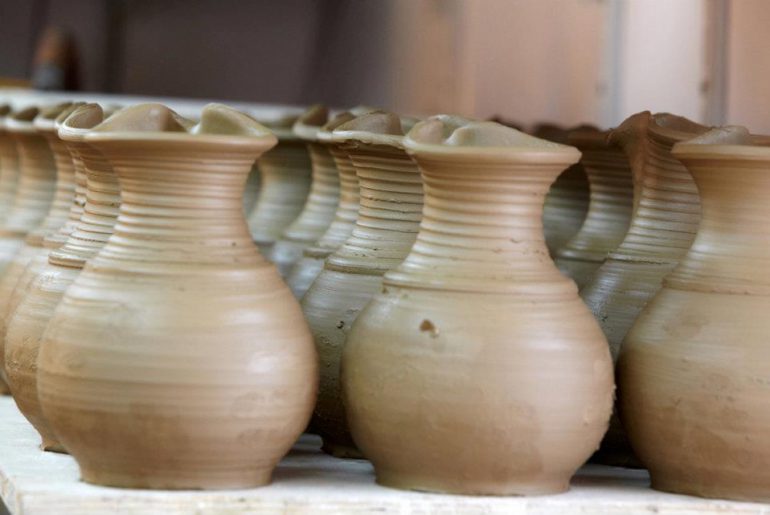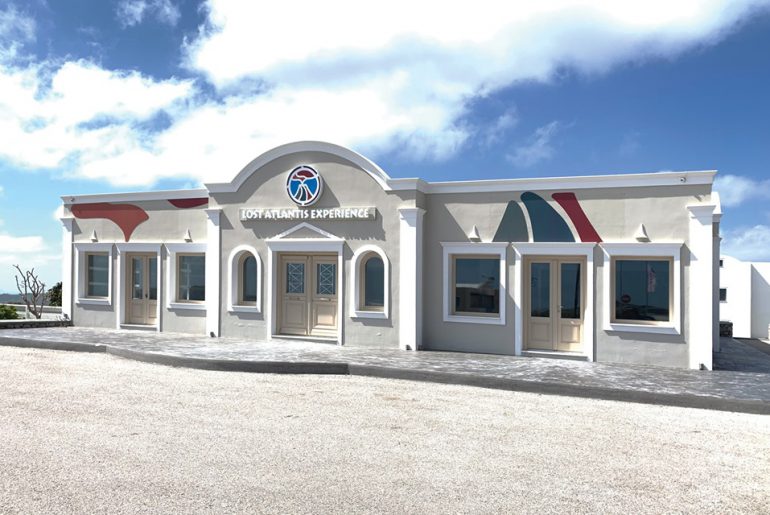Santorini is the iconic Greek destination with the most fascinating sunsets and postcard-pretty cliff houses carved on the slopes of the caldera, coated in sparkling white, which contrast with the light cobalt blue of the church domes and with the vivid magenta of the bougainvillea in bloom. It’s an island with a rich past, albeit checkered at times, a brilliant example of human endurance in challenging conditions. So, we’ve rounded up eight of the must-see museums in Santorini that show some of the historical trials that make the island great.
Lignos Folklore Museum: Must-see in Kontochori
The Lignos Folklore Museum is located in Kontochori, just a short 30-minute drive from Santo Maris Oia Luxury Suites & Spa. It occupies a traditional cave house that dates from 1861. The house survived the earthquake of 1956 and was restored in 1976.
Must-see in Santorini: Tomato Industrial Museum
The Tomato Industrial Museum is a fascinating attraction at the Santorini Arts Factory, which is a multi-purpose gallery and cultural space in Vlichada. It is a recent addition to the cultural stage of the island, as it opened its doors in 2014.
Must-see in Oia: Naval Museum of Thera
The Naval Museum of Thira in Oia opens at the beginning of April every year and welcomes visitors until the last day of October. Located in an old mansion, especially restored to fit its new purpose, the museum documents the maritime history of the island from ancient times to the XIX Century.
Must-see in Santorini: Museum of Minerals & Fossils in Perissa
The Museum of Minerals & Fossils is one of the main museums of Santorini, albeit not as known as the Museum of Prehistoric Thira in Firá. The museum is managed by the Cultural Society of Thira, and is located in Perissa.
Must-see in Santorini: Museum of Prehistoric Thira
The Museum of Prehistoric Thira is a Santorini attraction you shouldn’t miss. It is less than half hour drive from Santo Maris Oia Luxury Suites & Spa, in the capital of the island, Fira.
Wines of Santorini and a Visit to the Wine Museum
Oenophiles will find Santorini a fascinating destination: wine has been produced here since ancient times, and the wines of today still bear the influence of the winemaking traditions brought in the Middle Ages by Italians, when the island was under occupation by the Republic of Venice.
VILLAGE HOPPING: DISCOVER THE AUTHENTIC SIDE OF SANTORINI
Santorini is an island full of surprises and one way to discover them is to explore its stunning villages, each with its own unique personality and picturesque beauty. Distances are small between these delightful hamlets. They’re easy to visit, and each one, or a combination of a few, makes for a perfect day out. From north to south, this is Santo Collection Resorts & Villas’ guide to Santorini’s most lesser-known villages.
Pyrgos Kallistis
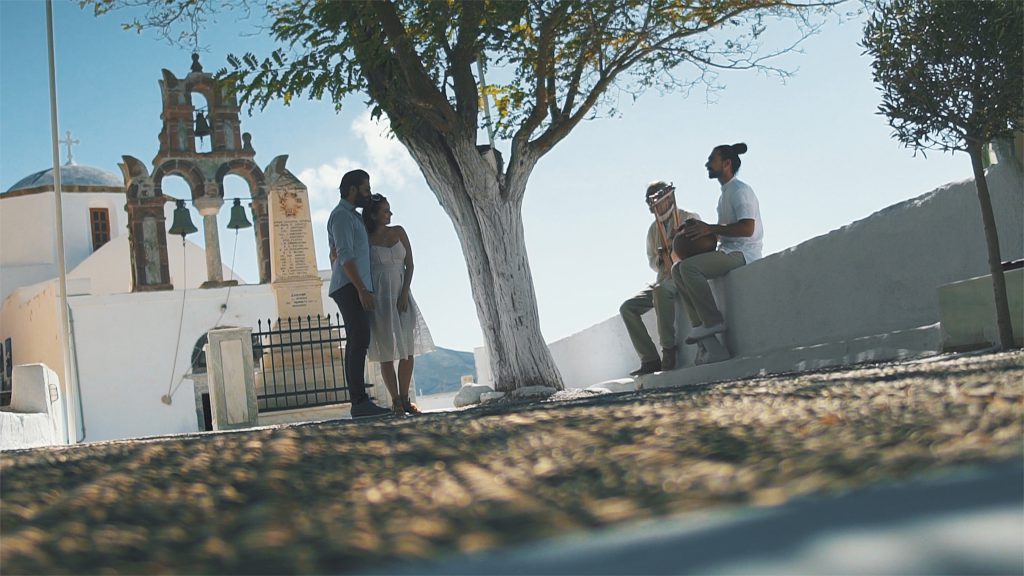
Ηilltop Pyrgos comprises the best-preserved medieval settlement on the island, and at the foot of Mount Profitis Ilias, the village combines its delightful tranquil ambience with panoramic views. This is a different side to Santorini – a community that exudes the Greek village of times gone by. The main square, with its pine trees and coffee shops, is good to visit late morning when locals gather for ouzo or Santorinian beer to compliment tasty mezzedes.
Set back from the caldera, Pyrgos doesn’t need the teeming terraces, bijou balconies and infinity pools, that make up much of what is today’s typical image of Santorini. This is a place that has witnessed a different and gentler path of development, but delightful creature-comforts are still to be found here. Its steep medieval alleys are home to some great wine bars, cafes, restaurants and boutiques. Head to the Santorini of the Past museum for insights into traditional island life. The Church of the Presentation of the Virgin Mary dating back to 1660 is one of Santorini’s largest and most important places of worship.
Finikia
A twenty-five minute walk less than two kilometres east of Santo Collection, the village of Finikia sits amongst terraced vineyards on a peaceful hillside. Pastel-coloured properties and boutique hotels plus a handful of traditional tavernas line the cobbled alleys of this picturesque community. Head towards the clifftop to the Profitis Ilias Church for a great viewing spot.
Karterados
A kilometre inland from Fira, the village of Karterados lies at the centre of Santorini, In the 19th century this was a glorious, prosperous settlement where sea captains built their stately homes and the architecture here is stunning. Cave houses dating from the 17th century, and a restored windmill in the main square add to the charm. Surrounding streets are lined with lively tavernas, restaurants and boutiques. Looking east over a lush green valley with vineyards, the remote Exo Gialos Beach is close by, with black volcanic pebbles and deep blue, crystal-clear waters. With fascinating rock formations (a result of salt and wind erosion) Exo Gialos is one of Santorini’s most unusual landscapes.
Megalochori
Megalochori still honours its elegant seventeenth-century roots, dotted with pirate hideaways and historic high-walled mansions with hidden courtyards. Tavernas and boutique hotels offer the customary caldera views, but it’s the vineyards in the surrounding hills that make Megalochori a place to truly savour. Wine-making is engrained in the area’s culture here and it’s where the island’s first commercial winemakers were established. Since Roman times, Santorini has made wines from a handful of specific grape varieties – Aidini, Assyrtiko, and Athiri for whites, and Mandilaria and Mavrotragano for reds. Vineyards flourish in Santorini’s black ash-rich volcanic soil and one-sixth (more than 1500 hectares) of the island is given over to wine production.
The main grape variety grown on the island is Assyrtiko covering 65 per cent of Santorini’s vineyards, and differing altitudes and soils result in varied styles. Most Santorini wines are known for their dry, crisp mineral-laden qualities. In the Megalochori area, sometimes referred to as “the Tuscany of the Aegean”, a vast wine culture can be explored.
From centuries-old subterranean wine cellars to ultramodern wineries hewn from the volcanic rock, Megalochori is a feast for the senses. Explore local producers like the family-run Gavalas Winery, the Hatzidakis Winery, and ArtSpace Winery – and a visit to the pioneering and architecturally stunning Venetsanos Winery overlooking the Caldera is a must.
Akrotiri
Eleven kilometres south-west of Fira, Akrotiri is a traditional village set in the island’s southernmost peninsular. Largely untouched by mass tourism, Akrotiri is one of the least developed parts of the island, is steeped in history, and makes for fascinating explorations.
Built below the now ruined 13th-century Fortress of Akrotiri, the modern-day village lies to the north and close by Ancient Akrotiri – the most important archaeological site on the island, which dates back to to the Bronze Age. Archaeologists believe the original settlement was constructed around 4,500 BC but destroyed by successive earthquakes and volcanic eruptions. On Santorini’s westernmost tip, a lighthouse (one of Greece’s oldest) dating from 1892, makes a fine location for watching that sunset with a difference.
Vlichada
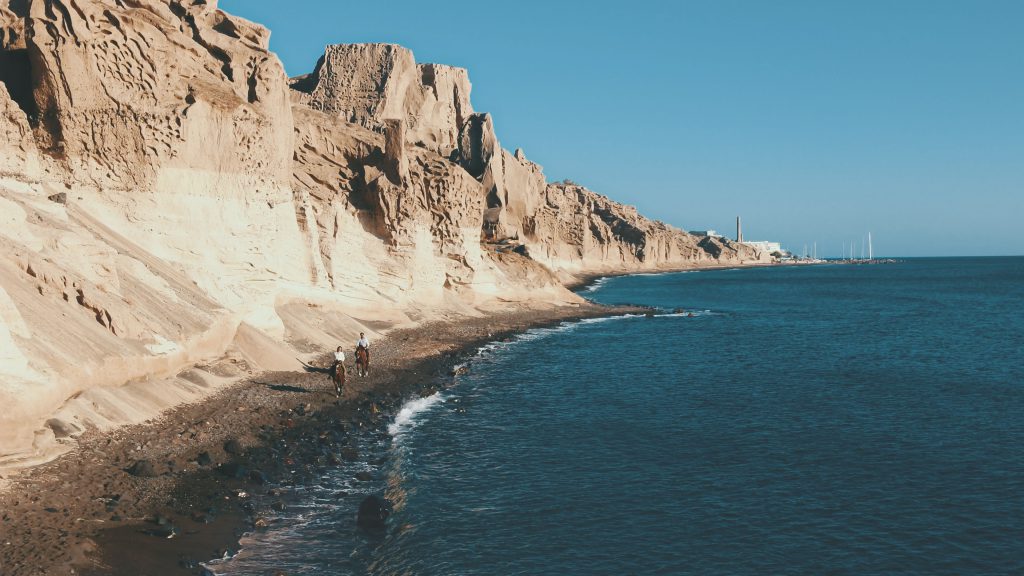 Quiet Vlichada village is famous for its black-pebble beach, backed by wind-sculpted, volcanic cliffs. Art exhibitions are held at the Santorini Arts Factory, and the village’s Tomato Industrial Museum featuring items used in the tomato-canning industry offers fascinating insights into this historic Santorini crop. Water’s edge seafood tavernas make this a great spot for a laid-back fishy lunch.
Quiet Vlichada village is famous for its black-pebble beach, backed by wind-sculpted, volcanic cliffs. Art exhibitions are held at the Santorini Arts Factory, and the village’s Tomato Industrial Museum featuring items used in the tomato-canning industry offers fascinating insights into this historic Santorini crop. Water’s edge seafood tavernas make this a great spot for a laid-back fishy lunch.
Ceramics and Pottery in Santorini
The roots of pottery tradition on Thira (alternative name of Santorini) can be traced long before the Minoan eruption of Santorini that occurred during the Late Bronze Age, which destroyed one of the most flourishing societies of the time. Excavations carried out at Akrotiri brought to light a settlement with multi-storey buildings and complex drainage systems, detailed furniture, striking frescoes, and ceramics that prove that the Minoan civilization at the time lived in peace and extraordinary prosperity. Most Santorinian potteries at the time were decorated with motifs, usually depicting cultivated plants, subjects from the marine life, and even terrestrial elements that echoed the Santorinian culture.The depiction of cultivated plants is a unique phenomenon in Aegean pottery and it first appeared on Thira during the Late Bronze Age. This is an aspect of art history, but also gives proof that the island occupied a significant position in the Cyclades. According to Marisa Marthari, the director of the excavations at Kastri-Chalandriani on Syros and Skarkos on Ios, Thira was “the producer of the richest pictorial pottery in the Aegean in the first period of the Late Bronze Age.” Vessels unearthed at Akrotiri support the theory that decorative painting was commonplace at the time. Popular motifs, like lilies and swallows found their way on vases, cookery pots, and frescoes quite often. Sometimes highly stylized, other times with a wealth of details, these symbols are still used by ceramists today and are characteristics of authentic Santorini ceramics. With such strong roots, no wonder that the pottery and ceramics of Santorini are among the most sought-after souvenirs from the island. Contemporary ceramists still produce vessels drawing on the rich past of this tradition. Here are some of the ceramic shops that will give you an idea of what to expect when you go pottery shopping on the island:
Akron Art Centre is owned by Dimitris Bellos and Aspasia Vovola. They are usually focused on replicas of ancient Santorini pottery art. This is a great place to visit to learn about the history of ceramics on the island. Akron is the only workshop of its kind in Santorini and one of the largest in Greece. They exhibit and sell Minoan, Geometric, and Classical era pottery from Santorini and from all over Greece.
1260° ceramic studio, owned by Marina Taliadourou and Giannis Vlantonopoulos, displays tableware ceramic objects inspired by the life and nature of Santorini. In the artists’ words: “The black volcanic earth, the red terracotta, the blue of the sea, the white and the red-orange color of the sunset.” Each piece is a one-of-a-kind. The name of the studio comes from a technique used to produce ceramics, firing them once at high temperatures.

Galatea’s Pottery and Art in Megalohori is a studio offering pottery designed by artist Galatea Papageorgiou. She has developed an individual style based on Santorini traditional art and you will notice a variety of motifs on her ceramics: caper leaf – inspired by a ceramic mug in the Museum of Prehistoric Thera, olive motif, Santorini motif – inspired by the traditional cave houses on the island, sea motif – inspired by Thalassa, the artist’s sister, wildflowers – an original theme, designed by the artist, as well as some stylized motifs, like meandros, leaves, dinner table, bamboo, and more.
EARTH and WATER, another pottery studio in Megalochori, is the studio of Athens-born ceramist Andreas Makaris, who lives and works in Santorini since 1985. As the artist testifies, his work is “inspired by the profuse light and the hidden mysteries of Santorini’s ancient past.” He shares the workshop with his wife, Kristi Kapetanaki, and their designs are in high demand on the island. They also offer pottery-making classes.
There are many other pottery stores on the island. Also, as you explore Oia, you will see ceramics in souvenir shops too. Don’t leave Santorini without visiting a ceramic store, buying a souvenir or joining a workshop that will always bring you in mind memories from Santorini!
The Lost Atlantis Experience
The Lost Atlantis Experience – an exciting state-of-the-art digital interactive experience exploring the myth of Atlantis – is a new and stunning addition to Santorini’s visitor attractions.
For thousands of years the story of the lost city of Atlantis, written by ancient Greece’s most famous philosopher Plato, has gripped the world. Capturing the imagination of millions, the tale of how an ancient island city, (believed by some to be Santorini), was created and then destroyed, is one of the great legends.
The founders of Atlantis were said to be half god, half man, a race who created a rich and powerful civilisation, but the city at the heart of the myth would be destroyed in a cataclysmic earthquake and tsunami – which, as the legend goes – was punishment by the gods for greed and immorality.
Now the story of Atlantis is being presented in a truly extraordinary way in Santorini itself, and it makes a stunning excursion for all the family. Using the latest interactive technology, visitors to the Lost Atlantis Experience Museum can experience everyday life in the mythical city through virtual ‘windows in time’, discover how the Minoan civilisation may well be at the heart of the Atlantis story, and even relive the earthquake, volcanic eruption and tsunami that caused the destruction of the city, using the latest ‘9D’ virtual reality.
Through its high-tech wonders the Experience allows visitors to explore Plato’s life journey through an interactive fresco, and engage with the famous philosopher, to find out more about the legendary city, and the theories surrounding its existence. This is history exploration with the accent on fun.
Having only opened its doors in May 2019, already the Lost Atlantis Experience has already received acclaim, with early visitors expressing their delight at this new and pioneering addition to Santorini’s attractions.
USEFUL INFORMATION:
The Lost Atlantis Experience is open daily, 09:00 – 21:00. 12€ adults, 6€ children (7-12). Children under 6 admitted free.
Please ask our Guest Experience Specialist in the reception of Santo Pure for details about the best way to arrange your visit.
2286 085076
Megalochori 84700

